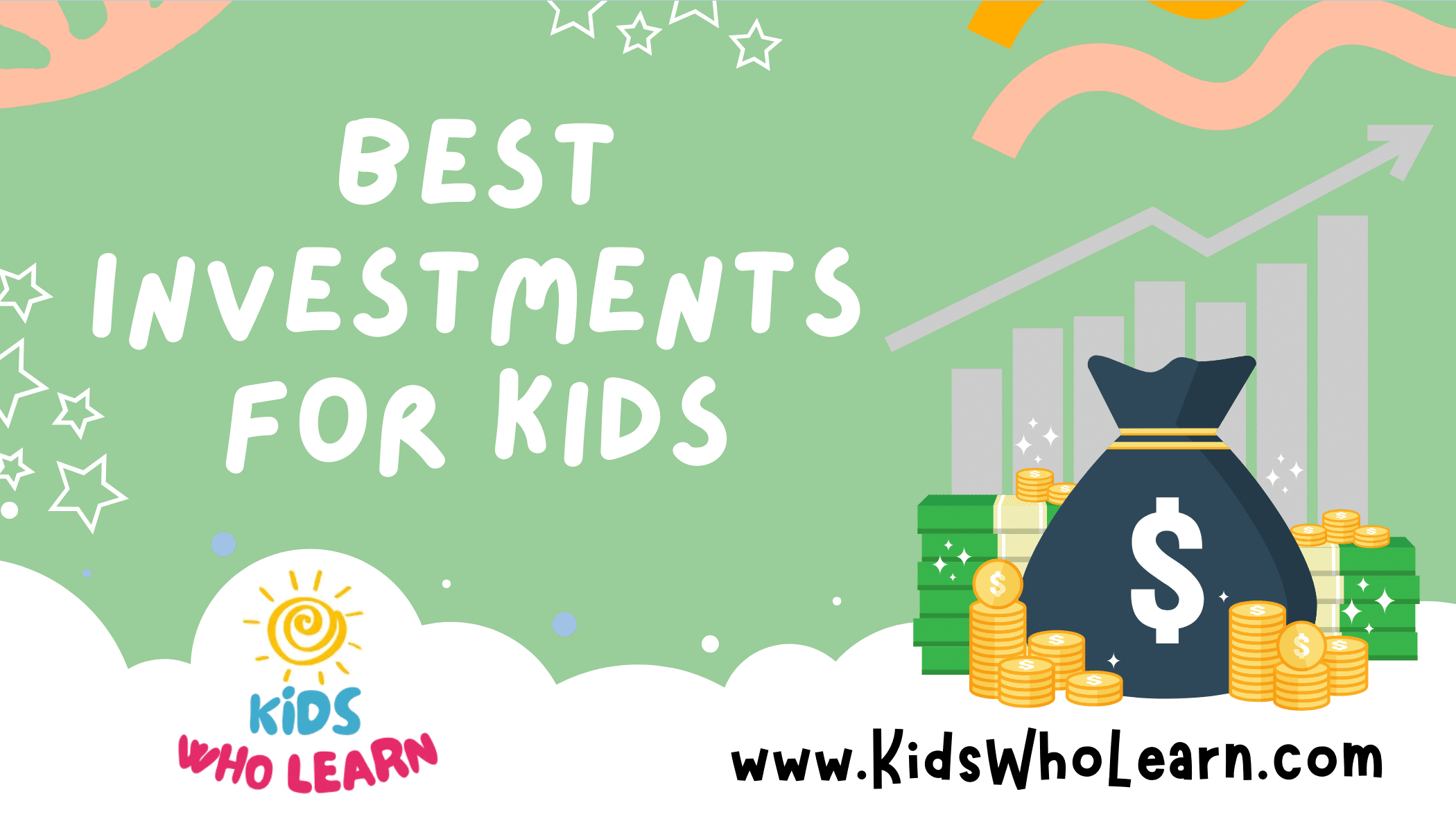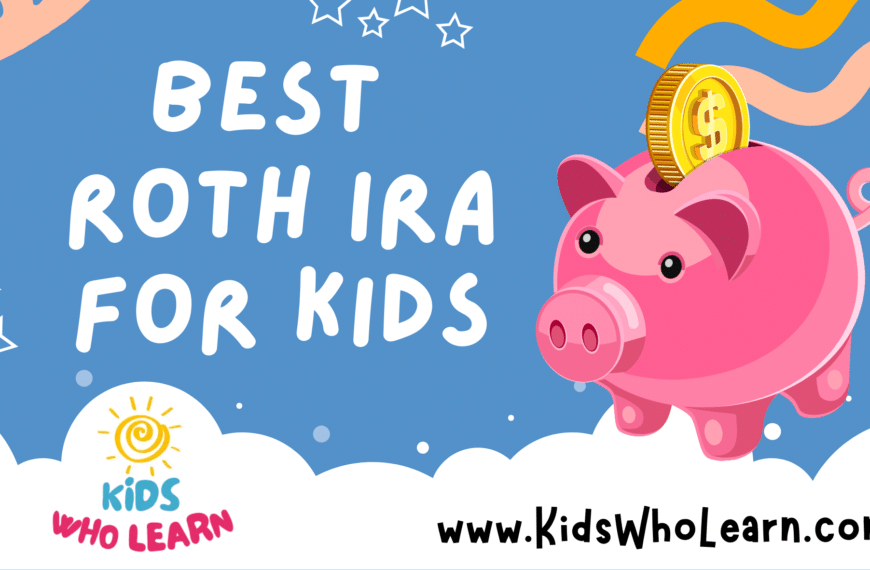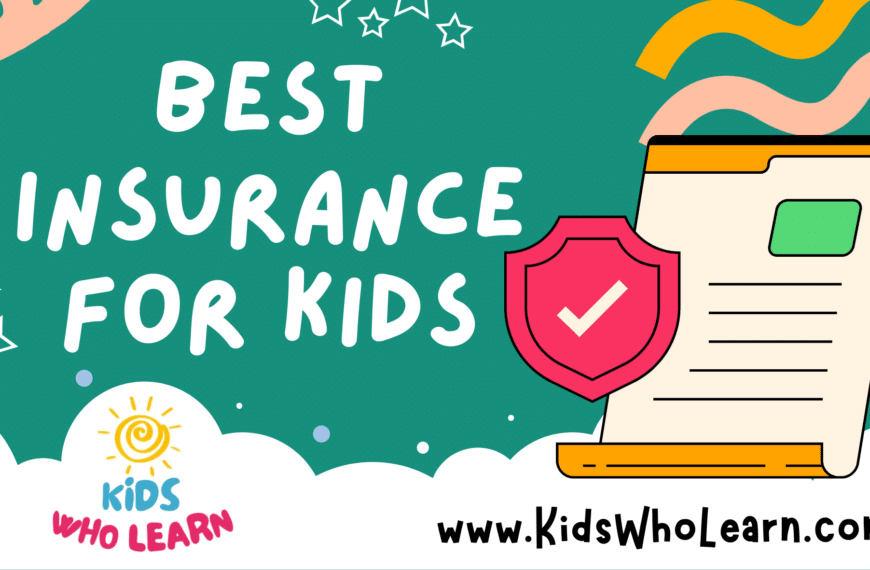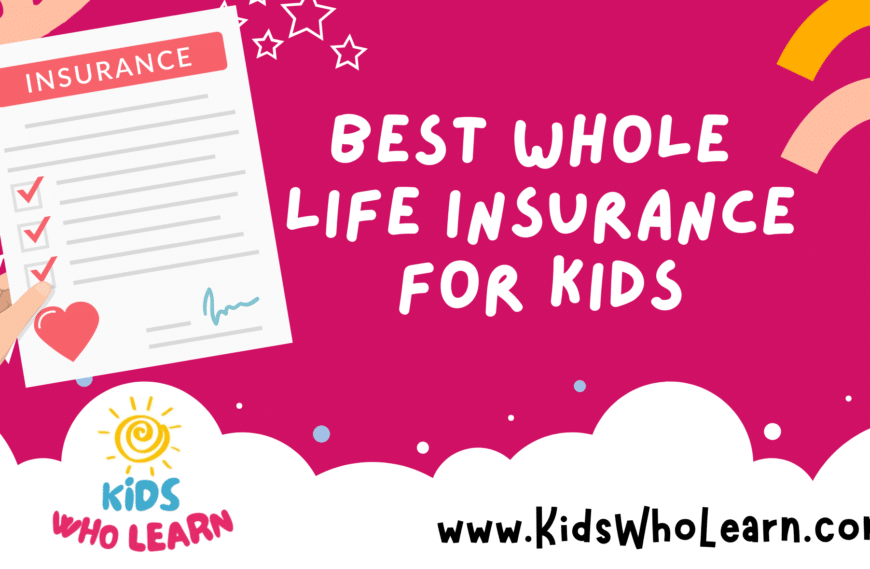Investing early in a child’s life not only prepares them for a more secure financial future but also provides a hands-on approach to financial literacy. Learning about money management through investments can be both educational and financially beneficial, setting a solid foundation for sound financial habits. By introducing children to the principles of investing, you instill in them an understanding of value, growth, and the importance of planning ahead.
There are numerous investment options suitable for kids, each with its own set of benefits and learning opportunities. Parents can choose to open accounts that are specifically designed for minors, providing a structured environment where kids can watch their savings grow over time. These accounts often come with tax advantages that enhance the potential return on investment. As children grow older, their understanding of money and investments deepens, allowing investment strategies to evolve with their increasing knowledge and maturity. Initiating the journey into investing at a young age equips them with the tools needed to make informed decisions about their finances in adulthood.
Key Takeaways
- Early investment educates children on financial literacy and instills sound money management from a young age.
- There are tailored investment accounts that offer educational value and tax benefits suitable for minors.
- As children mature, their investment strategies can adapt, providing ongoing learning and preparation for their financial future.
Understanding Investment Fundamentals
Investing early in life can greatly influence your financial future. Grasping the basics and understanding the different investment opportunities available to you, along with the associated risks and potential rewards, will help you in making informed decisions.
The Importance of Investing Early
By starting to invest at a young age, you give your investments the maximum amount of time to grow. Compound interest plays a crucial role here; it allows your income to generate more income by reinvesting your earnings. This effect can turn regular contributions into substantial savings over time, enhancing the value of your investment account.
Basic Investment Concepts
To begin, it’s vital to understand the relationship between saving and investing. Saving typically involves putting money aside for future use and is usually low risk, often in a savings account. On the other hand, to invest means to use your money to acquire assets that you believe will increase in value over time.
Key concepts include:
- Income: The return you get from an investment.
- Time horizon: The expected timeframe you plan to invest before needing the money.
- Risk: The chance that an investment’s value will decrease.
- Diversification: Spreading out investments to reduce risk.
Investment Types and Options
Various investment options are available, each with different characteristics and purposes:
| Investment Type | Description | Risk Level |
|---|---|---|
| Savings Accounts | Low-risk; suitable for short-term savings. | Low |
| Stocks | Potential for high return; represents share in a company. | Variable, generally higher |
| Bonds | Fixed income security; lower risk than stocks. | Low to Medium |
| Mutual Funds | Pools money from many investors to invest diversely. | Variable |
| ETFs (Exchange-Traded Funds) | Tradable like a stock; tracks index, commodity, or other assets. | Variable |
Each option has its own level of risk, potential return, and role in a diversified portfolio.
Risk Versus Reward
The fundamental trade-off in investing is risk versus reward. Generally, higher risk equates to the potential for higher reward, but also a greater chance of loss. Your risk tolerance should align with your time horizon: if you have time to recover from potential losses, you might consider riskier investments. Conversely, if you’ll need the money soon, lower-risk options could be more suitable.
Understanding these principles will help to build a strong foundation for your investing journey.
Accounts Suitable for Kids
Investing for the future is a critical aspect of financial education, and there are specific accounts tailored to empower kids financially. Opting for the correct type of account can significantly affect their future financial landscape.
Savings Accounts and Their Benefits
Savings Accounts are a fundamental financial tool designed for kids. They offer a safe place for money to grow at a steady, though modest, interest rate. By starting with a Youth Savings Account or a Money Market Account, you provide a secure environment where your child can learn the basics of money management with minimal risk.
Custodial Roth IRAs for Kids
Custodial Roth IRAs allow kids with earned income to begin saving for retirement, benefiting from tax-free growth. This early investment can compound over time, potentially yielding significant benefits. It’s important to ensure their job is IRS-qualified for Roth IRA contributions.
529 Plans and ESAs
529 Plans and Education Savings Accounts (ESAs) are specialized, tax-advantaged accounts focusing on education expenses. Contributions grow tax-free and are not taxed when withdrawn for qualified educational costs. Consider:
- 529 Plan: For college and now K-12 tuition.
- ESA: More investment options than a 529, but lower contribution limits and income restrictions apply.
UTMA and UGMA Accounts
Uniform Transfers to Minors Act (UTMA) and Uniform Gifts to Minors Act (UGMA) are custodial accounts that hold assets for children until they reach adulthood. These accounts can include a wider range of assets than other kid-centric accounts, like stocks, bonds, or insurance policies. Remember, these funds become the child’s legal property at the age of majority.
Teaching Kids About Money
Introducing children to financial concepts early on lays the groundwork for responsible money management in the future. Below you’ll find the essential steps to equip your child with the necessary monetary skills.
Financial Literacy’s Role
Financial literacy is the cornerstone of sound money management. By teaching your kids the basics of financial literacy, such as the value of money, saving, and budgeting, you’re setting them up for lifelong fiscal responsibility. For instance, when you explain how a budget works, you give them a framework for understanding spending and saving.
Hands-On Financial Education
A hands-on approach can significantly enhance your child’s understanding of money. Consider activities like:
- Opening a savings account: Teach them how to manage an account and monitor their balance.
- Investing in stocks: Small, kid-friendly investments can demonstrate how money grows over time.
- Participating in family budgeting: Involve them in allocating funds for different household categories.
These real-life practices help cement the concepts of earnings, savings, and investment.
Allowances and Money Responsibilities
Allowances can be a powerful tool in teaching kids about fiscal responsibility. Establish a system where your kids earn their allowance through chores or tasks. This practice teaches them the value of work and the money earned from it. Encourage them to manage their allowance by:
- Setting aside a portion for savings
- Allocating funds for their various wants and needs
- Tracking their spending with a simple budget sheet
Assigning financial responsibilities helps them understand the consequences of financial decisions and the importance of budgeting.
Investment Strategies for Different Ages
When choosing investment strategies for kids, it’s crucial to consider their age and the corresponding time horizon for the investment. Younger children have a longer time horizon, which can affect the types of investments that are suitable.
Investments for Young Children
For young children, you have the advantage of a long investment horizon, which means you can consider growth-oriented investment vehicles. A popular option is to open a Custodial Roth IRA if your child has earned income. This allows the earnings to potentially grow tax-free. Alternatively, a 529 College Savings Plan is designed specifically for education expenses and can offer tax advantages.
- Custodial Roth IRA: Contribute to a Roth IRA in your child’s name to take advantage of tax-free growth over several decades.
- 529 College Savings Plan: Invest in a state-sponsored education plan with tax benefits to fund your child’s future education costs.
Investments for Teenagers and Pre-Teens
As children grow into teenagers and pre-teens, they can be more involved in investment decisions. It’s an opportune time to introduce them to stocks and bonds. Starting with a diversified portfolio can help manage the risks while still allowing for growth.
- Stocks: Consider investing in individual stocks or low-cost index funds to begin building a portfolio.
- Bonds: Add a mix of government and corporate bonds to provide a balance of growth and security.
For teens, setting up a custodial brokerage account can be an educational tool. It’s a chance for them to learn investment basics with real-world applications.
- Custodial Brokerage Account: Use this account to teach teens about the stock market, trading, and long-term investing principles.
Remember, the earlier you start investing for children, the more opportunity for growth there is due to compounding returns. It’s essential to choose investments that align with the child’s age, time horizon, and future financial goals.
Tax Considerations
When investing for kids, it’s crucial to understand how these investments can affect your taxes, and how to utilize tax-advantaged investment accounts to optimize your financial strategy.
Understanding Tax Implications
Your child’s investments are subject to taxes, much like those of an adult. If your child’s investment generates more than a certain amount of taxable income in a year, it must be reported on tax returns. Investment income for minors is taxed according to the “kiddie tax” rules which apply to children under a certain age with unearned income. This includes interest, dividends, and capital gains. The first $1,100 of unearned income is typically tax-free, and the next $1,100 is taxed at the child’s rate. Any amount over $2,200 might be taxed at the parents’ higher rate, thereby reducing potential tax benefits.
Tax-Advantaged Investment Accounts
To maximize the tax benefits of investments for kids, consider utilizing tax-advantaged investment accounts such as:
- Custodial IRAs (Traditional or Roth): Traditional IRAs may offer tax deductions on contributions, with taxes deferred until withdrawals in retirement. Roth IRAs allow for tax-free growth and withdrawals if certain conditions are met, which can be particularly advantageous for the long-term growth potential of children’s investments.
- 529 College Savings Plans and Coverdell Education Savings Accounts (ESAs): These accounts are designed for educational expenses with contributions growing tax-free as long as withdrawals are used for qualified education costs.
- UGMA/UTMA Custodial Accounts: The Uniform Gifts to Minors Act (UGMA) and the Uniform Transfers to Minors Act (UTMA) allow you to open investment accounts in a minor’s name. While these are not tax-free, they offer some tax advantages. The first $1,100 of unearned income is tax-exempt, the next $1,100 is taxed at the child’s tax rate, and any income above that may be taxed at your rate. These accounts can serve as a general-purpose savings platform for future financial needs beyond education.
By leveraging these accounts appropriately, you can not only save for your child’s future but also potentially reduce the total amount of taxable income within your family each year.
Preparing for Higher Education Costs
Investing in your child’s education early can alleviate the financial burden when it’s time for college. Here is a structured strategy to ensure you’re well-prepared for the range of higher education costs.
College Funds
When you start saving for college, the 529 College Savings Plan offers a tax-advantaged way to save for your child’s future higher education expenses. Any gains in this account are tax-free if used for qualified education expenses. You can choose from a variety of investment options, and some states may offer tax benefits for contributions.
- Benefits of 529 Plans:
- Earnings grow tax-deferred
- No federal tax on withdrawals for qualified expenses
- Donor retains control of the account
- Can be transferred to another beneficiary if needed
Qualified Education Expenses
Funds from a 529 plan or a Coverdell Education Savings Account can be used for various qualified education expenses, ensuring that the money you save contributes directly to your child’s college costs. Qualified expenses typically include tuition, room and board, books, computers, and equipment required for attendance.
- Qualified Expenses include:
- Tuition and fees
- Room and board (if enrolled at least half-time)
- Books, supplies, and equipment
- Computers and related technology
- Additional expenses for students with special needs
Note: Using funds for non-qualified expenses may result in taxes and penalties.
Alternative Education Savings
Besides 529 plans and Coverdell accounts, you may explore other options like custodial accounts under the Uniform Gifts to Minors Act (UGMA) and the Uniform Transfers to Minors Act (UTMA). Keep in mind these accounts offer less tax advantage, and the assets become the property of the child when they reach legal age.
- Alternative Savings Vehicles:
- UTMA/UGMA Custodial Accounts
- Ownership transfers to minor at age of majority
- Less tax-advantaged compared to education-specific accounts
- No restrictions on expenditures once the child becomes an adult
- UTMA/UGMA Custodial Accounts
By addressing college costs now, you’re taking an important step in your child’s education journey. Starting early can ensure that when your child steps into adulthood, they have the financial resources to pursue the future they envision.
Specific Investment Vehicles for Kids
When planning your child’s financial future, it’s essential to pick investment vehicles that match their long-term goals and risk tolerance. Here, we’ll discuss the types of investments suitable for children.
Stocks and Bonds
Investing in stocks allows your child to own a fraction of a company, with the potential for growth and dividends over time. Bonds, on the other hand, are fixed-income securities that can provide a more stable, though typically lower, return. Consider custodial accounts like an IRA, which can hold both stocks and bonds for your child’s benefit.
- Stocks: Potential for high returns; choose companies with solid growth prospects.
- Bonds: Lower risk; consider government or corporate bonds aiming for steady income.
Mutual Funds and ETFs
Mutual funds are pooled investments managed by professionals, while Exchange-Traded Funds (ETFs) can be bought and sold like stocks. Investing in these funds often means exposure to a diverse portfolio of stocks or bonds, reducing risk.
- Mutual Funds: Managed diversification; research funds with strong track records.
- ETFs: Lower fees; look for funds that track broad market indexes for diversified exposure.
Safe Investment Options
For a conservative approach, certificates of deposit (CDs) and Treasury securities are safe investment options. You can count on CDs for fixed interest rates over a set period, whereas Treasury securities are backed by the U.S. government, making them virtually risk-free.
- Certificates of Deposit (CDs): Fixed interest rates; choose terms that align with your child’s future needs.
- Treasury Securities: Minimal risk; ideal for preserving capital for your child’s future.
Roles and Responsibilities in a Child’s Investment
When it comes to investments for children, it’s critical to understand the distinct roles and responsibilities assigned to both the parents and the young investor. This structure ensures that the child’s financial future is carefully planned and secured.
The Role of Parents and Guardians
As a parent or guardian, you are primarily responsible for setting up and managing investment accounts for your minor child. With your oversight, a custodial account can be established using your child’s social security number. This account will remain under your control until the child reaches the age of majority, which varies by state but is generally 18 or 21 years old.
- Setup: Initiate the investment account in the child’s name.
- Management: Oversee the account’s investments and transactions.
Understanding Ownership and Control
Even though the custodial account is in your child’s name, and they are the beneficial owner, as the custodian, you have control over the investments until they reach adulthood. It’s important to make investment decisions with the child’s long-term interests in mind, as these assets will legally transfer to them at the age of majority.
- Custodial Role:
- Control Over Decisions: Until the child is an adult.
- Beneficiary: The child as the ultimate owner.
Transitioning to Adult Financial Independence
As your child approaches the age of majority, preparing them for financial independence becomes critical. This involves educating them on the responsibilities of owning and managing investments and gradually involving them in the decision-making process.
- Preparation Steps:
- Education: Informing about financial basics.
- Involvement: Including in investment decisions for a smoother transition.
Managing and Accessing Funds
When investing for kids, it is essential to understand how to manage and access the funds. This includes knowing the specifics of withdrawals, potential penalties, and the flexibility in utilizing the investment funds.
Withdrawals and Penalties
Withdrawals from a custodial brokerage account are irrevocable and must be used for the benefit of the minor. Once your child reaches the age of majority, typically 18 or 21, they gain complete control over the account and can make withdrawals without any penalties. If you withdraw funds before this age, you may incur penalties or taxes, depending on the account’s earnings and its intended use.
- Penalty-Free Withdrawals: Some accounts may offer options for penalty-free withdrawals for qualifying educational expenses.
- Earnings: Withdrawals from earnings within the account may be subject to federal income tax, but typically at the child’s tax rate.
Flexibility in Using Investment Funds
Custodial accounts offer a degree of flexibility concerning the spending of investment funds. You’re able to select from a wide range of investment options with a custodial brokerage account to suit your investment goals for the child’s future needs, whether it’s for education, a down payment on a home, or other expenditures.
- Brokerage Account Features: Numerous brokerage accounts provide features that may allow for strategic planning, such as selecting specific investments for growth or stability.
- Patterns of Spending: Although the funds must be used for the child’s benefit, you can strategically plan the spending for when the child gains control, which may include large, one-time expenses or longer-term investment strategies.
Planning for Long-Term Goals
When it comes to investing for kids, long-term goals such as retirement and major life events require strategic planning. The earlier these investments begin, the more time compound interest can work to your advantage.
Retirement Savings for Kids
Opening a Retirement Account: Setting up a retirement savings account for your child might seem premature, but it’s a forward-thinking move. If they have earned income, you can contribute to a Custodial Roth IRA on their behalf. As of the current tax year, the maximum yearly contribution is $6,000, or the total amount of their earned income, whichever is less.
Selecting Investments: For long-term growth, consider a mix of stocks, bonds, and mutual funds tailored to retirement. Over time, adjusting the portfolio to a more conservative mix can help protect the savings as your child approaches retirement age.
Investing for Major Life Events
Plan and Prioritize: Major life events like purchasing a home require significant planning. Start by creating a dedicated investment account to save for a down payment. Encourage regular contributions to this account to meet your financial goal.
Diversified Portfolio: A diversified mix of investments can minimize risks and provide stable growth. Options such as index funds, ETFs, and bonds can be suitable for this purpose. As the target date for the event nears, shifting towards more conservative options can help safeguard the accumulated funds.
| Term | Suggested Action |
|---|---|
| Retirement Savings | Open a Custodial Roth IRA and invest in a diversified portfolio. |
| Major Life Event Savings | Set up a dedicated investment account and contribute regularly. |
Earning and Contributing to Investments
Investing for your children sets a foundation for their future financial success. Understanding how to earn and save money, as well as the regulations around contributions, is crucial for maximizing these early investments.
Teaching Kids to Earn and Save
Teaching your kids about earned income is the first step towards empowering them to invest. This can involve simple tasks like doing chores for an allowance, or for older kids, taking on part-time work such as babysitting. Instill in them the habit of saving a portion of their income. For example:
- Allowance: If you give your child $10 weekly, encourage saving $3.
- Part-time Jobs: Help them set aside a percentage of their wages into a savings account.
Once your child has saved money, you can guide them to contribute to their investment accounts with these after-tax dollars, demonstrating how their savings can grow over time.
Contribution Limits and Regulations
When your children start earning, it’s important to be aware of the contribution limits and regulations that apply to investment accounts for minors. Different accounts have different rules, but here are some general guidelines:
- Custodial Roth IRAs: Kids can contribute the lesser of their taxable income or $6,000 for 2023.
- 529 College Savings Plans: Contributions are not limited by the child’s income, but there are annual gift tax exclusion limits to consider, which is $16,000 per individual for 2023.
Keeping track of their income and ensuring contributions to their investment accounts are within legal limits is key to avoiding penalties and maximizing potential growth. Remember, consistent contribution, even in small amounts, can accrue significant value over time.
Seeking Professional Advice
Investing on behalf of your children can establish a foundation for their financial future. Navigating this path often requires not just careful thought but also specialized knowledge.
When to Consult a Financial Advisor
When considering setting up investment accounts for your children, the right time to consult a financial advisor is when you need expert guidance tailored to your family’s goals and risk tolerance. A financial advisor can:
- Assess Your Financial Goal: By understanding your specific objectives, such as saving for college or building a nest egg for your children, a financial advisor can suggest the best account types suitable for your goals.
- Understand Risk Tolerance: They can gauge your comfort with risk and recommend investment options that align with your risk tolerance.
- Educational Savings Plans: Financial advisors are versed in educational savings plans like 529 plans or Coverdell ESAs, which can be beneficial if education is a priority.
- Tax Implications: They can provide insight into potential tax benefits and consequences of investing for minors, such as the use of a custodial IRA for employment income if your child has a job.
- Long-term Strategy: Crafting a long-term investment strategy that considers market fluctuations and adjusts as your child grows closer to adulthood.
- Diverse Investment Options: With access to a broad range of investment products, advisors can help diversify the investments within the account to balance growth and risk.
Leveraging the expertise of a financial advisor can be a pivotal step in creating a robust financial plan for your kids.
Digital Investment Platforms for Kids
Investment platforms designed for kids aim to make financial education engaging and accessible, while offering a practical experience in managing investments.
Modern Apps and Tools
Acorns: Acorns facilitates micro-investing by rounding up your purchases to the nearest dollar and investing that spare change. It’s a user-friendly platform that exposes you to the concept of investing without requiring large sums of money. For kids and teenagers, Acorns Early can be particularly beneficial, providing an early start to the world of investing within a custodial account.
Webull: Geared more towards young adults, Webull offers a more hands-on approach to investing with an advanced platform that includes detailed analytics and commission-free trades. While not designed specifically for kids, its features can be greatly educational for teens interested in learning about the stock market and ETFs with parental guidance.
Stash: Stash is another platform that allows you to start investing with a small amount of money. The Stash app includes educational content tailored to help you understand investing basics. Parents can use Stash to create custodial accounts and select from various ETFs to invest in, making it a practical tool for teaching investment strategies to kids.
Exchange-Traded Funds (ETFs): ETFs are investment funds traded on stock exchanges, much like stocks. They are ideal for young investors on these digital platforms to diversify their portfolios with minimal risk. ETFs are accessible through the apps mentioned above and allow you to invest in a wide range of assets, offering exposure to different industries and economies.
Using these digital investment platforms can give you, as a young investor, a solid footing in the financial world, helping you to learn and grow your investments over time.
Dealing with Debt and Investments
Investing for your children’s future is an essential strategy for their financial well-being, but navigating the potential pitfalls of debt in the process is crucial. Ensuring that investments don’t exacerbate financial pressures, especially from student loans, requires careful planning.
Avoiding Debt while Investing for Kids
When setting aside money for your children, prioritize contributions to investment accounts that won’t burden your financial situation. Use these strategies:
- Budget Wisely: Allocate funds to investments after monthly expenses and emergency savings to avoid borrowing.
- Low-Cost Options: Opt for low-fee investment plans such as 529s or UTMA/UGMA accounts, which can grow tax-free for educational purposes.
Remember that avoiding high-interest debt now can lead to a stronger investment outcome for your child in the long run.
Student Loan Debt Considerations
If you carry student loan debt, balance repayment with investing for your child with these tips:
- Interest Rates: Compare your student loan interest rates against potential investment returns. If loans cost more, prioritize their repayment.
- Loan Types: Federal student loans offer more flexible repayment options than private ones. Factor this into how aggressively you invest versus pay down debt.
- Refinancing Options: Refinancing student loans at a lower interest rate can free up money for investing without significantly altering your debt repayment timeline.
Balancing your own student debt with your child’s investment needs careful financial management, but it’s an achievable goal with the right approach.
The Future of Investing for the Youth
Investing for your financial future has never been more accessible. With technological advancements, the youth now have an array of options to secure their economic well-being.
Accounts Best Suited for Young Investors:
- Custodial Accounts (UGMA/UTMA): These allow you to invest on behalf of a minor, with assets transferred to them once they reach legal age.
- 529 Plans: Specifically designed for educational expenses, they offer tax benefits and can be an integral part of planning for your child’s future.
Investing early can tap into the power of compound interest, making time a strong ally for your investments to grow. Becoming financially literate and understanding the market trends can help you make informed investment decisions. Moreover, new fintech solutions and apps are tailored to help young investors to routinely invest small amounts, often through accessible platforms.
When considering the best account for your child to invest in, diversification is key. You can take steps to ensure a robust portfolio by combining stocks, bonds, and other securities. This approach can help mitigate risks and work towards a steady financial future.
It is important to remain mindful of the evolving market landscape that your child will face. The rise of sustainable and socially responsible investing reflects the values of the younger generation, highlighting that investments can align with personal ethics while still aiming for profitability.
By engaging with the investment world now, you can provide a foundation for your child to build upon as they grow, offering them not just financial security, but a thorough understanding of what it takes to maintain it.
Frequently Asked Questions
Making informed decisions about your child’s financial future is paramount. The following are specific questions to assist you in navigating the investment options suitable for your child.
What are the most suitable investment accounts for children?
Custodial accounts like the UGMA (Uniform Gift to Minors Act) and the UTMA (Uniform Transfers to Minors Act) provide a means for holding and protecting assets for minors until they reach adulthood. A 529 Plan is also beneficial for saving for your child’s education, offering tax advantages and potential financial aid benefits.
How can parents set up a mutual fund for their child?
You can start by opening a custodial account under the UGMA or UTMA wherein you can purchase mutual funds on behalf of your minor child. Choose a fund with an investment objective that matches your time horizon and risk tolerance for your child’s future needs.
What are the steps to initiate an investment fund for a newborn baby?
First, decide on the type of investment account you want to open for your baby. A 529 college savings plan can be initiated with your newborn as the beneficiary for education expenses, while a custodial brokerage account allows investment in stocks, bonds, and mutual funds for any purpose.
What options are available for creating a custodial Roth IRA for my child?
If your child has earned income, you can open a custodial Roth IRA in their name. Contributions are made with after-tax dollars, and the account grows tax-free, with the potential for tax-free withdrawals in retirement.
What considerations are important when choosing a custodial brokerage account for a child?
Look for accounts with low fees, a user-friendly platform, and access to a diversified range of investment products. Also, consider whether the account provider offers educational resources that can help your child learn about investing.
How can a trust fund be utilized for a child’s financial future?
A trust fund can be set up to manage and protect assets for your child’s benefit. You can stipulate how and when the assets are distributed, which can provide financial security and support for education, purchase of a first home, or other significant life events.













